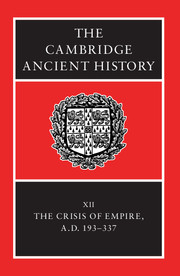Book contents
- Frontmatter
- PART I NARRATIVE
- PART II GOVERNMENT AND ADMINISTRATION
- PART III THE PROVINCES
- PART IV THE ECONOMY OF THE EMPIRE
- 11 Coinage and taxation: the state's point of view, a.d. 193–337
- 12 Coinage, society and economy
- PART V THE NON-ROMAN WORLD
- PART VI RELIGION, CULTURE AND SOCIETY
- Chronology
- Bibliography
- Index
- Topographical map of the Roman empire
- Map 2 The Roman empire in a.d. 211
- The Roman empire in a.d. 314
- The Rhine–Danube limes in the late second century
- References
11 - Coinage and taxation: the state's point of view, a.d. 193–337
from PART IV - THE ECONOMY OF THE EMPIRE
Published online by Cambridge University Press: 28 March 2008
- Frontmatter
- PART I NARRATIVE
- PART II GOVERNMENT AND ADMINISTRATION
- PART III THE PROVINCES
- PART IV THE ECONOMY OF THE EMPIRE
- 11 Coinage and taxation: the state's point of view, a.d. 193–337
- 12 Coinage, society and economy
- PART V THE NON-ROMAN WORLD
- PART VI RELIGION, CULTURE AND SOCIETY
- Chronology
- Bibliography
- Index
- Topographical map of the Roman empire
- Map 2 The Roman empire in a.d. 211
- The Roman empire in a.d. 314
- The Rhine–Danube limes in the late second century
- References
Summary
Even if, with the notable exception of Pliny the Elder, the ancient authors say little on the subject and show no real concern to provide accurate figures, the coinage appears to have played a key role in the actual operation of the Roman imperial system. Protected from the ravages of time by its very nature, it fills the coin rooms of museums all over the world. As collectors' items, coins are nowadays quoted as valuable commodities on the market. They are along with pottery the most common Roman artefacts to survive to the present. Yet the modern interest in coinage should not make us forget the place that coins occupied in both the Roman economy and culture.
Regularly struck and restruck with the portraits of the new principes (whose image was sacred), often referring to those events of their reigns deemed to be the most glorious and laden with complex religious and political meanings or messages, coins are during the whole imperial period the most widespread daily signs of the emperors' power.
Gradually standardized by marginalization and then elimination of the local coinages which were still struck in some of the eastern provinces at least until the mid-third century, the coinage expresses and translates into reality, despite the considerable disparities in development among the provinces, the economic and political unity of the empire. However, at the end of the third century and at the beginning of the fourth, the division of the empire among two or four co-emperors leads to a proliferation of coinages which, even in the same denomination, will not automatically have the same fineness and weight.
- Type
- Chapter
- Information
- The Cambridge Ancient History , pp. 327 - 392Publisher: Cambridge University PressPrint publication year: 2005
References
- 13
- Cited by

